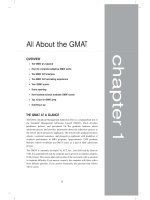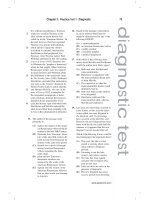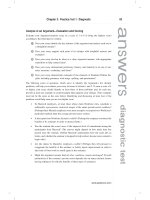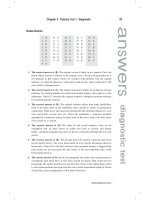Master gmat 2010 part 17 docx
Bạn đang xem bản rút gọn của tài liệu. Xem và tải ngay bản đầy đủ của tài liệu tại đây (47.55 KB, 10 trang )
WORDY AND AWKWARD PHRASES
With enough words, anyone can make the point, but it requires skill and effort to make your
point with concise phrases. As you proofread your essay, if you detect a sentence that’s clumsy
or too long, check for a wordy, awkward phrase that you can replace with a clearer, more
concise one. Here are two examples (replace italicized phrases with the ones in parentheses):
Discipline is crucial to the attainment of one’s objectives. (attain)
To indicate the fact that they are in opposition to a bill, legislators sometimes
engage in filibusters. (To show their)
Look for the opportunity to change prepositional phrases into one-word modifiers:
The employee with ambition
The ambitious employee
You can often rework clauses with relative pronouns (that, who, which, etc.), omitting the
pronoun:
The system, which is most efficient and accurate
The most efficient and accurate system . . .
In your Argument essay, you can replace wordy phrases that signal a premise with a single
word:
Wordier: the reason for, for the reason that, due to the fact that, in light of the fact
that, on the grounds that
More concise: because, since, considering that
REDUNDANT WORDS AND PHRASES
As you proofread your essays, check for words and phrases that express the same essential
idea twice.
Both unemployment levels as well as interest rates can affect stock prices. (Replace
as well as with and or omit both.)
The reason science is being blamed for threats to the natural environment is
because scientists fail to see that technology is only as useful, or as harmful, as
those who decide how to use it. (Replace because with that,oromitthe reason
and is.)
USING TOO FEW (OR TOO MANY) COMMAS
Although punctuation is the least important aspect of your GMAT essays, misplacement,
overuse, or underuse of commas might interfere with the reader’s understanding of a
sentence. Too few commas might confuse the reader; too many can unduly interrupt the
sentence’s flow. Here’s the guideline: Use the minimum number of commas needed to ensure
that the reader will understand your point.
TIP
The rules of
grammar
reviewed in
the Sentence
Correction lessons
in this book
should help you
compose and
profread your
essays as well.
Chapter 6: Writing Style and Mechanics 143
www.petersons.com
Your Facility with the English Language
To ensure yourself top scores on your essays, strive to convince the reader that you possess a
strong command of the English language—in other words, that you can use the language
correctly, clearly, and persuasively in writing. To show the reader the requisite linguistic
prowess, try to do these three things:
Demonstrate a solid vocabulary.
Use proper idioms (especially prepositional phrases).
Use proper diction (word usage and choice).
DEMONSTRATING A SOLID VOCABULARY
By all means, show the reader that you possess the vocabulary of a broadly educated
individual and that you know how to use it. But keep the following five caveats in mind:
Don’t overuse SAT-style words just to make an impression. Doing so will only serve
to warn the reader that you’re trying to mask poor content with window dressing.
Avoid obscure or archaic words that few readers are likely to know. The reader will
not take time to consult an unabridged dictionary.
Avoid technical terminology that only specialists and scholars in a specific field
understand. GMAT readers are typically English-language generalists from the
academic fields of English and communications, not economic-policy analysts.
Use Latin and other non-English terms very sparingly. After all, one of the primary
skills being tested through the GMAT essays is your facility with the English
language. However, the occasional use of Latin terms and acronyms—for example,
per se, de facto, ad hoc, and especially i.e., and e.g.,—are perfectly acceptable.
Non-English words used commonly in academic writing—such as vis-à-vis, caveat,
and laissez faire—are acceptable as well. Again, just don’t overdo it.
Avoid colloquialisms (slang and vernacular).
YOUR DICTION AND USE OF IDIOMS
In evaluating your essays, GMAT readers also take into account your diction and use of
idioms—again, especially when problems in these areas interfere with the readers’
understanding of your essays. Here you’ll learn tips for avoiding, or at least minimizing,
diction and idiom errors in your essays.
Diction (Word Choice and Usage)
Diction refers to word choice and the manner in which you use the word. For instance, you
might confuse one word with another because they look or sound similar, or you may choose a
word that doesn’t accurately convey your idea. Here’s an example of each type of diction error:
144 PART III: GMAT Analytical Writing Assessment
NOTE
The GMAT word
processor does
not allow you to
italicize or mark
accents on
foreign wor ds. It’s
okay to leave
them as is, but
make sure
they’re commonly
understood wor ds.
www.petersons.com
Word choice error:
The best way to impede employees to improve their productivity is to allow them to
determine for themselves the most efficient way of performing their individual
job tasks.
(The word impede means “to hinder or hamper.” In the context of this sentence
impede should be replaced with a word such as impel, which means “propel or
drive.” The test taker might have confused these two words.)
Word usage error:
Unless the department can supply a comparative cost-benefit analysis for the two
alternative courses of action, I would remain diffident about following the depart-
ment’s recommendation.
(The word diffident means “reluctant, unwilling, or shy.” A more appropriate word
here would be ambivalent, which means “undecided or indecisive.” Or perhaps the
test taker meant to use the word indifferent (thereby committing the first type of
diction error).
What appear to be diction errors might, in many instances, be mere clerical (typing) errors.
Accordingly, problems with your word choice and usage will adversely affect your scores only
if they are obvious and occur frequently.
Idiom
An idiom is a distinctive (idiosyncratic) phrase that is considered proper or improper based on
whether it has become acceptable over time, through repeated and common use. Here are two
sentences, each of which contains an idiomatic prepositional phrase and another idiom.
Example (from a typical Issue essay):
The speaker’s contention flies in the face of the empirical evidence and, in any
event, runs contrary to common sense.
Example (from a typical Argument essay):
For all we know, last year was the only year in which the company earned a profit,
in which case the vice president’s advice might turn out especially poor in retrospect.
Tips for Avoiding Diction and Idiom Errors
Idioms don’t rely on any particular rules of grammar; they are learned over time by
experience. As you might suspect, the English language contains more idiomatic expressions
than you can imagine. Moreover, the number of possible diction errors isn’t limited to the
number of entries in a comprehensive unabridged English dictionary. Although it is
impossible in these pages to provide an adequate diction or idiom review, we can provide some
guidelines to these aspects of your writing:
• If you’re the least bit unsure about the meaning of a word you intend to use in your
essay, don’t use it. Why risk committing a diction blunder just to impress the reader
Chapter 6: Writing Style and Mechanics 145
www.petersons.com
with an erudite vocabulary? (And if you’re not sure what “erudite” means, either
find out or don’t use it in your essays!)
• If a phrase sounds wrong to your ear, change it until it sounds correct to you.
• The fewer words you use, the less likely you’ll commit an error in diction or idiom.
So when in doubt, go with a relatively brief phrase that you still think conveys
your point.
• If English is your second language, take heart: In evaluating and scoring your
essays, GMAT readers take into account diction or idiom problems only to the extent
that those problems interfere with understanding your sentence’s intended
meaning. As long as your writing is understandable to your EFL (English-as-first-
language) friends, you don’t need to worry.
If you have ample time before your exam and you think your diction and use of idioms could
stand improvement, check for errors in your practice essays by consulting a reputable
guidebook to English usage. Or you might consult a trusted professor, colleague, or
acquaintance who has a firm grasp of the conventions of Standard Written English.
ADVANCED TECHNIQUES
As you know by now, although GMAT readers place less weight on writing style and
mechanics than on content and organization, the way you write can affect your AWA score,
especially if you’ve written an otherwise borderline essay that has the reader “on the fence”
between two scores.
Earlier in the chapter, you learned some basic tips for style and mechanics. Here, we’ll move
on to more advanced techniques. We’ll review the following:
• A variety of rhetorical devices that, if used appropriately and prudently, add
persuasiveness to essays (especially your Issue essay)
• How to connect your ideas together with words and phrases that will help the reader
follow your reasoning as you proceed from one point to the next
• The parlance of Critical Reasoning and how to use it properly (in your
Argument essay)
• How to refer to yourself, to the statement or Argument, and to the author of the
statement or Argument
Developing a Persuasive Writing Style
Earlier in this book, you learned how to develop persuasive ideas (especially for your Issue
essay) and to structure and sequence your paragraphs in ways that enhance their
persuasiveness. To further ensure a high AWA score, you should try to use particular words
and phrases that can be especially effective rhetorically. However, you should also avoid
words and phrases that amount to so-called empty rhetoric. You can also use irony, and even
punctuation, for rhetorical emphasis.
146 PART III: GMAT Analytical Writing Assessment
www.petersons.com
RHETORICAL WORDS AND PHRASES BY FUNCTIONAL CATEGORY
Here’s a reference list of rhetorical words and phrases categorized by function. Some list items
you encountered as underlined words and phrases in the examples throughout this book;
others are new.
Use phrases such as these to subordinate an idea:
although it might appear that, at first glance it would seem/appear that, admittedly
Use phrases such as these to argue for a position, thesis, or viewpoint:
promotes, facilitates, provides a strong impetus, serves to, directly, furthers, accom-
plishes, achieves, demonstrates, suggests, indicates
Use phrases such as these to argue for a solution or direction based on public policy or some
other normative basis:
ultimate goal/objective/purpose, overriding, primary concern, subordinate,
subsumed
Use phrases such as these to refute, rebut, or counter a proposition, theory, or viewpoint:
however, closer scrutiny reveals, upon closer inspection/examination, a more thor-
ough analysis, in reality, actually, when viewed more closely, when viewed from
another perspective, further observation shows
Use phrases such as these to point out problems with a proposition, theory, or viewpoint:
however, nevertheless, yet, still, despite, of course, serious drawbacks, problematic,
countervailing factors
Use phrases such as these to argue against a position or viewpoint:
works against, undermines, thwarts, defeats, runs contrary to, fails to achieve/
promote/accomplish, is inconsistent with, impedes
Use phrases such as these to argue that the merits of one position outweigh those of another:
on balance, on the whole, all things considered, in the final analysis
AVOID EMPTY RHETORIC
Many test takers try to mask weak ideas by relying on strong rhetoric. Be careful in using
words and phrases such as these for emphasis:
clearly, absolutely, definitely, without a doubt, nobody could dispute that, ex-
tremely, positively, emphatically, unquestionably, certainly, undeniably, without
reservation
It’s okay to use them, but keep in mind that by themselves, they add absolutely no substance
to your ideas. You must be certain that you have convincing reasons and/or examples to back
up your rhetoric.
Chapter 6: Writing Style and Mechanics 147
www.petersons.com
USING IRONY AS A RHETORICAL DEVICE
In your Issue essay, look for the opportunity to use words in their ironic sense or as
misnomers for rhetorical emphasis—in other words, to help make your point. Read the Issue
statement closely for key words. Here’s one example of each:
Example (irony):
The speaker fails to consider the long-term cultural impact of the kinds of techno-
logical “advancements” I’ve just described.
Example (misnomer):
The “knowledge” to which the statement refers is, in actuality, only subjective
perception.
Be sure to use quotation marks for the ironic term or misnomer, whether or not you’re quoting
the Issue statement.
USING PUNCTUATION FOR RHETORICAL EMPHASIS
You can also use punctuation for rhetorical emphasis. Here are four suggestions (try them out
during the Practice Tests in Part VI):
Use em-dashes (two hyphens or one hyphen preceded and followed by a space) in
the middle of a sentence—instead of commas or parentheses—to set off particularly
important parenthetical material (as in this sentence). You can also use an em-dash
instead of a comma before a concluding phrase to help set off and emphasize what
follows. But don’t overuse the dash or it will lose its punch.
Use exclamation points for emphasis very sparingly. As in this paragraph, one per
essay is plenty!
Sentences that pose questions can be a useful rhetorical device. Like short, abrupt
sentences, rhetorical questions can help persuade the reader or at least help to
make your point. They can be quite effective, especially in Issue essays. They also
add interest and variety. Yet how many test takers think to incorporate them into
their essays? Not many. (By the way, we just posed a rhetorical question.) Just be
sure to provide an answer to your question. And don’t overdo it; one rhetorical
question per essay is plenty.
Avoid using UPPERCASE letters, *asterisks, or similar devices to flag words you
would emphasize in rhetorical speech. To get your point across, rely instead on your
choice of words and phrases and your sentence construction.
Connecting Your Ideas
Your essays will not earn top scores unless your ideas flow naturally from one to the next,
allowing the reader to easily follow your train of thought. To connect your ideas, develop your
own arsenal of transition devices—words and phrases that serve as bridges between ideas—to
convey your line of reasoning to the reader.
148 PART III: GMAT Analytical Writing Assessment
www.petersons.com
Each transition device should help the reader make certain connections or assumptions about
the two areas that you are connecting. For example, some devices lead your reader forward
and imply the building of an idea or thought, while others prompt the reader to compare ideas
or draw conclusions from the preceding thoughts.
Here’s a reference list that includes many of those devices—by functional category.
To signal addition:
and, again, and then, equally important, finally, further, furthermore, nor, too,
next, lastly, what’s more, in addition
To connect ideas:
furthermore, in addition, also, [first, second . . .], moreover, most important/signifi-
cantly, consequently, simultaneously, concurrently, next, finally
To signal comparison or contrast:
but, although, conversely, in contrast, on the other hand, whereas, except, by
comparison, where, compared to, weighed against, vis-à-vis, while, meanwhile
To signal proof:
because, for, since, for the same reason, obviously, evidently, furthermore, more-
over, indeed, in fact, in addition, in any case, that is
To signal exception:
yet, still, however, nevertheless, in spite of, despite, of course, occasionally, some-
times, in rare instances, infrequently
To signal sequence (chronological, logical, or rhetorical):
[first, second(ly), third(ly) . . .], next, then, now, at this point, after, in turn,
subsequently, finally, consequently, previously, beforehand, simultaneously, concur-
rently
To signal examples:
for example, for instance, perhaps, consider, take the case of, to demonstrate, to
illustrate, as an illustration, one possible scenario, in this case, in another case, on
this occasion, in this situation
To signal your reasoning from premise to conclusion:
therefore, thus, hence, accordingly, as a result, it follows that, in turn
Use these phrases for your concluding or summary paragraph:
in sum, in the final analysis, in brief, summing up, in conclusion, to conclude, to
recapitulate, in essence, in a nutshell
Chapter 6: Writing Style and Mechanics 149
www.petersons.com
Using the Language of Critical Reasoning
You don’t need to resort to the technical terminology of formal logic in your essays. However,
you will need to use less technical words, such as “argument,” “assumption,” “conclusion,” and
possibly “premise” and “inference,” especially in your Argument Analysis essay. Be sure you
understand what these words mean and that you’re using them correctly. Here are definitions
and usage guidelines for these terms.
Argument: The process of reasoning from premises to conclusion
To describe a flawed argument, use adjectives such as weak, poor, unsound, poorly
reasoned, dubious, poorly supported, and problematic.
To describe a good argument use adjectives such as strong, convincing, well rea-
soned, and well supported.
You don’t “prove an argument”; rather, you “prove an argument (to be) true.”
(However, the word “prove” implies deduction and should be used sparingly, if at
all, in your Argument essay.)
Premise: A proposition helping to support an argument’s conclusion
Use the words premise and evidence interchangeably to refer to stated information
that is not in dispute.
Assumption: Something taken for granted to be true in the argument (Strictly speaking,
assumptions are unstated, assumed premises.)
To describe an assumption, use adjectives such as unsupported, unsubstantiated,
and unproven.
To describe a particularly bad assumption, use adjectives such as unlikely, poor,
questionable, doubtful, dubious, and improbable.
To strengthen an argument, you substantiate an assumption or prove (or show or
demonstrate) that the assumption is true. (However, be careful in using the word
prove; it is a strong word that implies deduction.)
Strictly speaking, an assumption is neither “true” nor “false,” neither “correct” nor
“incorrect.” Also, you don’t “prove an assumption.”
Conclusion: A proposition derived by deduction or inference from the premises of
an argument
To describe a poor conclusion, use adjectives such as indefensible, unjustified,
unsupported, improbable, and weak.
To describe a good conclusion, use adjectives such as well-supported, proper, prob-
able, well-justified, and strong.
Although you can “prove a conclusion” or “provide proof for a conclusion,” again the
word “proof” implies deduction. You’re better off “supporting a conclusion” or “show-
ing that the conclusion is probable.”
150 PART III: GMAT Analytical Writing Assessment
www.petersons.com
Inference: The process of deriving from assumed premises (assumptions) either a strict
conclusion or a conclusion that is to some degree probable
You can describe an inference as poor, unjustified, improbable, or unlikely.
You can also describe an inference as strong, justified, probable, or likely.
You can “infer that . . .”, but the phrase “infer a conclusion” is awkward.
Deduction: The process of reasoning in which the conclusion follows necessarily from the
premises (Deduction is a specific kind of inference.)
References to Yourself and to the Statement or Argument
While writing your essays, you may occasionally need to refer to the Issue statement or
Argument or its hypothetical source, whether a person or entity. You might also wish to refer
to yourself from time to time. Here are some guidelines for handling these references.
SELF-REFERENCES
Self-references—singular and plural—are perfectly acceptable, though optional. Just be
consistent.
“I disagree with ”
“Inmyview, ”
“Without additional evidence, we cannot assume that ”
REFERENCES TO THE STATEMENT OR ARGUMENT
In your Issue essay, refer to the statement as “this statement” or an alternative such as “this
claim” or “this assertion.” In your Argument essay, try using “argument” to refer to the
passage’s line of reasoning as a whole or “recommendation” or “claim” to refer to specific
conclusions.
REFERENCES TO THE SOURCE OF THE STATEMENT OR ARGUMENT
Be sure your references to a statement or Argument’s source are appropriate. In your Issue
essay, you can simply refer to the statement’s source as the “speaker,” for example. In your
Argument essay, the first time you refer to the source, be specific and correct—e.g., “this
editorial,” “the ad,” “the vice president,” or “ACME Shoes.” If no specific source is provided, try
using “author” or “argument.”
PRONOUN REFERENCES TO AN ARGUMENT’S PROPONENT
In your Argument essay, it’s okay to save keystrokes by using an occasional pronoun. Just be
sure that your pronouns are appropriate and consistent (he/she or neither):
“The speaker argues Her line of reasoning is butshe overlooks.
“The manager cites insupport of his argument He then recommends
“To strengthen its conclusion, the city council must It must also ”
ALERT!
GMAT Argument
Analysis essays do
not involve
deduction, so
avoid using any
form of the word
deduction in
that essay.
Chapter 6: Writing Style and Mechanics 151
www.petersons.com
Also, be sure that your pronoun references are clear. Don’t use a pronoun if it is separated
from its antecedent (the noun that it describes) by one or more sentences.
SHORTHAND REFERENCES TO AN ARGUMENT’S SOURCE AND EVIDENCE
It’s perfectly acceptable to save keystrokes with shorthand names or acronyms in place of
multiple-word proper nouns. If you use an acronym, be sure to identify it the first time you
use it. For example:
In this Argument, the marketing director for Specialty Manufacturing (SM) recom-
mends that SM discontinue its line of
QUOTING THE STATEMENT OR ARGUMENT
Occasionally, it may be appropriate to quote key words or phrases from the Issue statement or
Argument. For example, you may wish to point out to the reader a key phrase that is
ambiguous or vague (e.g., “certain respondents”) or a term that is overly inclusive or exclusive
(e.g., “only” or “all”). Just keep the number of quoted words and phrases to a minimum. And
remember: there’s never any justification for quoting entire sentences.
152 PART III: GMAT Analytical Writing Assessment
NOTE
Readers don’t
care whether you
use masculine,
feminine, or
gender-neutral
terms in your
essays, but be
sure to keep it
consistent.
Alternating male
and female
examples and
expressions might
confuse the
reader.
www.petersons.com









